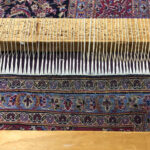What to Do When Your Rug Suffers Water Damage
Get a Quote
Water damage can be incredibly distressing for rug owners. The soft and luxurious piece that graced your floor can quickly turn into a sodden, discolored mess if not addressed promptly. Thankfully, with swift action and the right approach, many water-damaged rugs can be restored to their former glory. Here’s what you should know.
Understanding the Implications of Water Damage
When rugs remain wet for extended periods, several problems can arise:
- Discoloration: Water can cause dyes to bleed, leading to color changes or uneven patches on the rug.
- Mildew and Mold Growth: Damp environments are breeding grounds for fungi. These growths not only smell unpleasant but can also harm the rug’s fibers and pose health risks.
- Weakened Fibers: Prolonged moisture exposure can weaken rug fibers, making them brittle or causing them to rot.
- Odors: A wet rug can develop a musty or foul odor, indicative of bacterial growth.
Immediate Steps to Take
If your rug gets wet, acting quickly can prevent long-term damage:
- Remove Excess Water: Gently blot the rug using towels to absorb as much water as possible. Avoid rubbing, as this can damage the fibers and cause color bleeding.
- Elevate the Rug: If possible, prop the rug up or hang it in a way that allows air circulation on both sides.
- Use Fans: Position fans to blow air across the rug’s surface to speed up drying.
- Dehumidify: If you have a dehumidifier, use it. This machine can help extract moisture from the air, making the drying process more effective.
Professional Cleaning and Restoration
While the steps above can mitigate immediate issues, it’s often essential to seek professional help for thorough cleaning and restoration:
- Expert Assessment: Professionals can evaluate the extent of the damage and suggest the best course of action.
- Advanced Drying Techniques: Pros use specialized equipment to ensure complete drying, preventing mold growth and structural damage.
- Cleaning and Sanitizing: Beyond just drying, professionals will clean and sanitize the rug, ensuring all contaminants and bacteria are eliminated.
- Restoration: In cases where the rug’s colors have bled or the structure has been compromised, experienced restorers can reweave or recolor affected areas.
Preventing Future Water Damage
Prevention is always better than cure:
- Positioning: Avoid placing rugs in areas prone to water spillage, like under potted plants or close to entryways.
- Waterproof Padding: Consider using a waterproof pad beneath your rug, especially in potentially damp areas like basements.
- Regular Inspection: Check for signs of water leaks in areas where your rug is placed.
FAQ
Mold can start growing within 24 to 48 hours in a damp environment. It’s vital to start the drying process immediately after a rug becomes wet.
While many rugs can be restored, the success largely depends on the extent of the damage, the type of water (clean water vs. sewage), and how quickly restoration begins. Some severely damaged rugs might be beyond repair.
The rug might feel dry on the surface, but moisture can remain trapped in the deeper fibers. Professionals use moisture meters to ensure complete dryness.
While it’s possible, it’s not the best method. Hairdryers can be too hot and damage the fibers or cause uneven drying. Fans and dehumidifiers are better options.
A musty smell is a sign of mildew or mold growth. It’s crucial to ensure the rug is thoroughly dried, cleaned, and sanitized. If the odor persists, seek professional cleaning.
Water damage can be a significant threat to the aesthetics and longevity of your rug. However, with prompt action and the right expertise, it’s possible to salvage and restore your water-afflicted treasure. Whether you’re dealing with a minor spill or a major flood, understanding the steps to take can make all the difference in preserving your rug’s beauty and value.



